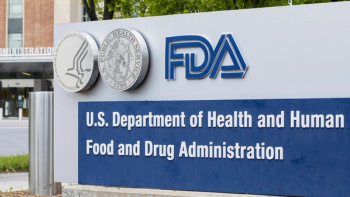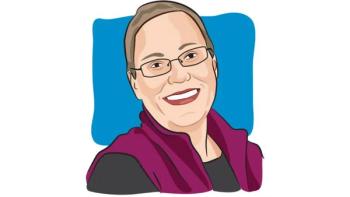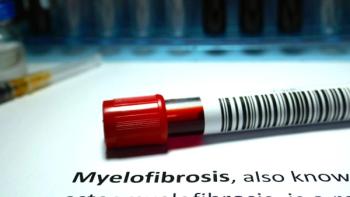
Mezigdomide Regimen Promising for Relapsed/Refractory Myeloma
Mezigdomide plus Velcade and dexamethasone or Kyprolis and dexamethasone showed promising response rates across multiple doses in patients with relapsed or refractory multiple myeloma, research showed.
The novel drug, mezigdomide, plus Velcade (bortezomib) and dexamethasone or Kyprolis (carfilzomib) and dexamethasone, led to promising responses in patients with relapsed or refractory multiple myeloma, according to follow-up from the phase 1/2 dose-escalation/-expansion CC-92480-MM-002 trial.
Results, which were presented at the 2023 IMS Annual Meeting, showed that, in a dose-escalation cohort (cohort A), the triplet regimen elicited an 77.8% objective response rate (ORR; percentage of patients whose disease shrunk or disappeared from treatment) at the 0.3-mg mezigdomide dose (nine patients), which included a 22.2% stringent complete response (sCR; a measure when there are no detectable plasma cells or myeloma proteins found, according to the Multiple Myeloma Research Foundation) rate, a 22.2% very good partial response (VGPR; when there are no myeloma proteins observed in a urine test) rate, and a 33.3% partial response (PR; myeloma decreased but did not disappear) rate. One patient had stable disease (SD; myeloma stops growing) and one patient had progressive disease (PD).
At the 0.6-mg dose of mezigdomide (nine patients), the ORR was 88.9%, and one person each had an sCR, complete response (CR; when no myeloma can be detected), and VGPR; the PR rate was 55.6%. One patient had SD. At the 1-mg dose (10 patients), the ORR was 60.0% and one patient had an sCR; the VGPR rate was 30.0%, the PR rate was 20.0%, one patient had a molecular response (MR) and three patients (30.0%) had SD.
In a dose-expansion cohort of the combination treatment (cohort D), the ORR at the 0.6-mg dose (11 patients), was 90.9% and the sCR rate was 27.3%. The VGPR rate was 54.5%, the PR rate was 9.1%, and 1 patient had SD. At the 1.0-mg dose in this cohort (38 patients), the ORR was 84.2%, which included a 7.9% sCR rate, a 10.5% CR rate, a 44.7% VGPR rate, a 21.1% PR rate, and a 2.6% MR rate. The SD rate was 7.9%, the PD rate was 2.6%, and one patient was not evaluable.
“Responses were deep and durable, with many patients remaining on treatment after one year,” lead study author Albert Oriol, head of the Clinical Research Unit at Catalan Institute of Oncology and Josep Carreras Institute, Hospital Germans Trias i Pujol, in Badalona, Spain, said in a presentation during the meeting.
When studied in combination with dexamethasone alone, mezigdomide elicited clinical activity and had a manageable safety profile in patients with relapsed/refractory multiple myeloma.
In a phase 1 study, mezigdomide plus Velcade/dexamethasone and Kyprolis/dexamethasone in this patient population also had encouraging data. Here, the 1.0-mg dose plus Velcade/dexamethasone was identified to use in a dose-expansion cohort.
In the phase 1/2 CC-92480-MM-002 study, investigators evaluated mezigdomide with various treatment regimens in multiple myeloma. To be eligible for enrollment, patients must have had measurable multiple myeloma that had progressed during or after their most recent antimyeloma treatment and had a molecular response or better to at least one of their prior regimens, which include two to four for cohorts A and C, one to three for cohort D, and Revlimid (lenalidomide) for at least two consecutive cycles.
At the 2023 IMS, updated data from the mezigdomide plus Velcade/dexamethasone (MeziVd; cohort A) and Kyprolis/dexamethasone (MeziKd; cohort C) dose-escalation cohorts, and the MeziVd dose-expansion cohort (D) were reported. Cohort B, which comprised mezigdomide plus daratumumab (Darzalex) and dexamethasone, and cohort H, of mezigdomide plus Empliciti (elotuzumab) and dexamethasone, were not reported.
The main goals of the trial were the recommended dose and regimen for cohorts A and C, safety, and efficacy as it relates to ORR.
Regarding baseline characteristics in cohort A (28 patients), the median age was 65.5 years (range, 46-86) and 57.1% of patients were female. The median time since initial diagnosis was 4.8 years (range, 1.9-17.1), more than half (53.6%) had an ECOG performance status of 1, meaning that they could perform most of their daily tasks independently, and the International Staging System (ISS) was 1, 2 and 3 in 71.4%, 21.4%, and 7.1% of patients, respectively. A total 17.9% of patients had plasmacytomas present and 42.9% of patients had high-risk cytogenetics.
In cohort D (49 patients), the median age was 64.0 years (range, 43-83) and 32.7% of patients were female. The median time since initial diagnosis was 4.4 years (range, 0.9-20.5), more than half (51.0%) had an ECOG performance status of 1, and the ISS was 1, 2 and 3 in 69.4%, 18.4%, and 12.2% of patients, respectively. A total 10.2% of patients had plasmacytomas present and 55.1% of patients had high-risk cytogenetics.
In cohort C (27 patients), the median age was 68.0 years (range, 41-76) and 66.7% of patients were female. The median time since initial diagnosis was 5.4 years (range, 0.7-15.7), more than half (55.6%) had an ECOG performance status of 1, and the ISS was 1, 2 and 3 in 77.8%, 11.1%, and 11.1% of patients, respectively. A total 11.1% of patients had plasmacytomas present and 59.3% of patients had high-risk cytogenetics.
Most patients had been exposed to a proteasome inhibitor (cohort A, 96.4%; cohort D, 89.8%; cohort C, 100%), and were refractory to immunomodulatory agents (85.7%, 63.3%, and 88.9%), respectively. Fifty percent of patients in cohort A were refractory to a proteasome inhibitor vs 16.4% and 51.9% in cohorts D and C, respectively. Additionally, half of patients in cohort A were refractory to an anti-CD38 monoclonal antibody vs 34.7% in cohort D and 74.1% in cohort C. In cohorts A, D, and C, 32.1%, 2.0%, and 37.0% were triple-class refractory, respectively.
Most patients in cohort A (89.3%) discontinued treatment compared with 67.3% and 70.4% in cohorts D and C, respectively; this was due to side effects in 7.1%, 14.3%, and 14.8% of patients, respectively. Two patients died in cohort D and one in cohort C.
Additional efficacy findings showed that, in cohort A, the median time to first response (TTFR) was 1.38 months (range, 0.7-3.3), the median duration of response (DOR) was 10.9 months, and the follow-up time was 13.6 months (range, 3.2-44.7). In cohort D, the median TTFR was 0.89 months (range, 0.7-2.4), the median DOR was not reached, meaning that not enough patients had progressed to determine how long the average duration of response was, and the median follow-up time was 12.71 months (range, 1.5-26.1).
In the dose escalation cohort (cohort C), in patients who received the 0.3-mg dose (nine patients), the ORR was 88.9%, which included a 22.2% CR rate, a 33.3% VGPR rate, a 33.3% PR rate, and a 11.1% MR rate. The ORR was also 88.9% with the 0.6-mg dose (nine patients); the sCR rate was 11.1%, the VGPR rate was 22.2%, the PR rate was 55.6%, and 11.1% of patients had PD.
Finally, at the 1.0 mg-dose in cohort C (nine patients), the ORR with mezigdomide and Kyprolis/dexamethasone was 77.8%, with one CR, a 33.3% VGPR rate, a 33.3% PR rate, one MR, and 1 patient had SD. The median TTFR was 0.95 months (range, 0.9-5.1), the median DOR was 12.3 months, and the median follow-up time was 12.45 months.
Mezigdomide also elicited responses regardless of patients being refractory to prior therapy with Pomalyst (pomalidomide) as well as Revlimid and an anti-CD38 monoclonal antibody.
Pharmacodynamic activity was also observed with mezigdomide in combination with either Kyprolis or Velcade at all tested dose levels; the 1.0-mg dose of mezigdomide showed the greatest substrate degradation and immune modulation across cohorts.
In the dose-escalation phase 1 portion, all-grade treatment-emergent side effects at all doses in cohort A included neutropenia (53.6%), anemia (46.4%), and thrombocytopenia (35.7%). Infections occurred in 71.4% of patients at all doses in the form of upper respiratory tract infection (25%), pneumonia (10.7%), and COVID-19 (10.7%). Oriol noted that grade 3/4 side effects — meaning that they were moderate to severe — were mostly blood-related; there were few non-hematologic grade 3/4 side effects.
In the phase 2 dose-expansion portion, all-grade side effects at all doses in cohort D included neutropenia (77.6%), anemia (44.9%), and thrombocytopenia (49.0%). Infections occurred in 79.6% of patients at all doses in the form of pneumonia (28.6%) and COVID-19 (38.8%).
Similar results were observed in the phase 1 dose-escalation portion for cohort C. Here, all-grade side effects included neutropenia which was reported in 55.6% of patients, followed by thrombocytopenia (51.9%) and anemia (37.0%). Infections occurred in 70.4% of patients at all doses in the form of pneumonia (22.2%) and COVID-19 (51.9%).
These data, Oriol noted, support additional studies of mezigdomide in the phase 3 SUCCESSOR-1 and SUCCESSOR-2 trials in this patient population.
For more news on cancer updates, research and education, don’t forget to





